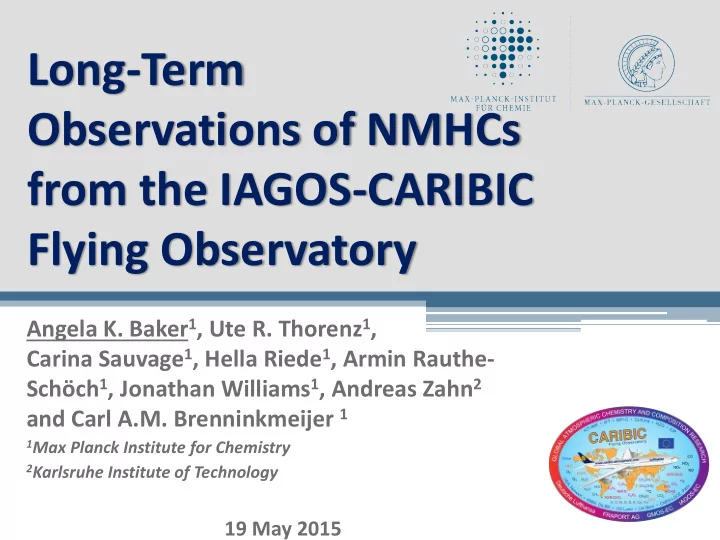

Long-Term Observations of NMHCs from the IAGOS-CARIBIC Flying Observatory Angela K. Baker 1 , Ute R. Thorenz 1 , Carina Sauvage 1 , Hella Riede 1 , Armin Rauthe- Schöch 1 , Jonathan Williams 1 , Andreas Zahn 2 and Carl A.M. Brenninkmeijer 1 1 Max Planck Institute for Chemistry 2 Karlsruhe Institute of Technology 19 May 2015
IAGOS-CARIBIC Observatory • In service Aircraft for a Global Observation System - Civil Aircraft for the Regular Investigation of the atmosphere Based on an Instrument Container • May 2005 – Present • 2-6 flights per month
Where We Fly
CARIBIC Whole Air Samples • 116 WAS/month (Schuck et al., 2009 & Baker et al., 2010 [AMT]) – 28 glass, 88 stainless steel – GHGs, nonmethane hydrocarbons (NMHCs), halocarbons • Stratospheric influence: – above the chemical tropopause (Zahn et al., 2003 [JGR]) – N 2 O >2 σ below tropospheric trend (Umezawa et al., 2014 [JGR]) – PV > 2 pvu, O 3 mole fraction > 150 ppb • 3132 Tropospheric, 2944 Stratospheric Influence (May 2005 – April 2014)
Main Players: Light NMHCs ETHANE PROPANE BUTANE C 2 H 6 C 3 H 8 n-C 4 H 10 lifetime ~40 days lifetime ~11 days lifetime ~5 days UT: always > LOD UT: always > LOD UT: 97% > LOD LMS: always > LOD LMS: 96% > LOD LMS: 64% > LOD Main sources are fossil fuel-related; small biomass burning source Main sink is via reaction with hydroxyl radical (OH)
NMHCs in the UT No statistically significant long-term trend Highly variable (natural variability + varying flight route)
UT Distributions: Ethane
UT Distributions: Propane
UT Distributions: Butane
NMHC Ratios
UT “Surface Character” • Use NMHC ratios to describe similarity of UT air to air at the surface below • UT ratios from CARIBIC • Surface ratios from EMAC simulations at 900hPa* ([A]/[B])UT surface character = ([A]/[B])surface (different • Lower values: more processing/dilution source ratio/ • Higher values: recent input of surface air region) * T42L90MA, 24h DOY mean 01.2005-06.2008, VOC emissions: EDGAR 3.2FT2000 + GFED suboptimal conditions used for “proof of concept” (Jöckel et al., 2006 [ACP]; 2010 [GMD]; Riede et al., 2010 [GMD])
UT “Surface Character” Air more resembles the surface moving to the equator Greatest surface character in summer
Air Mass “Age” N-S gradient which is greater in NH winter and fall Fairly “young” air in tropics; overall “younger” UT in summer
Methane and Ethane • Co-emitted from fossil fuel related sources • Varying ratios depending on source type • Relationship useful for understanding methane sources (India, Africa) • Can we do the same to understand N. American sources over the Atlantic?
Summary and Outlook • 10 years of CARIBIC NMHC data show no significant trends in the UT (except for benzene) • VOC ratios highlight influence of transport from the surface on UT composition • Increased surface character moving to equator • Transport “hot spots” stand out (convection, WCBs?) • Can we: • use these hot spots to understand sources and emissions? • use CARIBIC NMHCs to understand shortcomings in EMAC convection schemes?
Recommend
More recommend